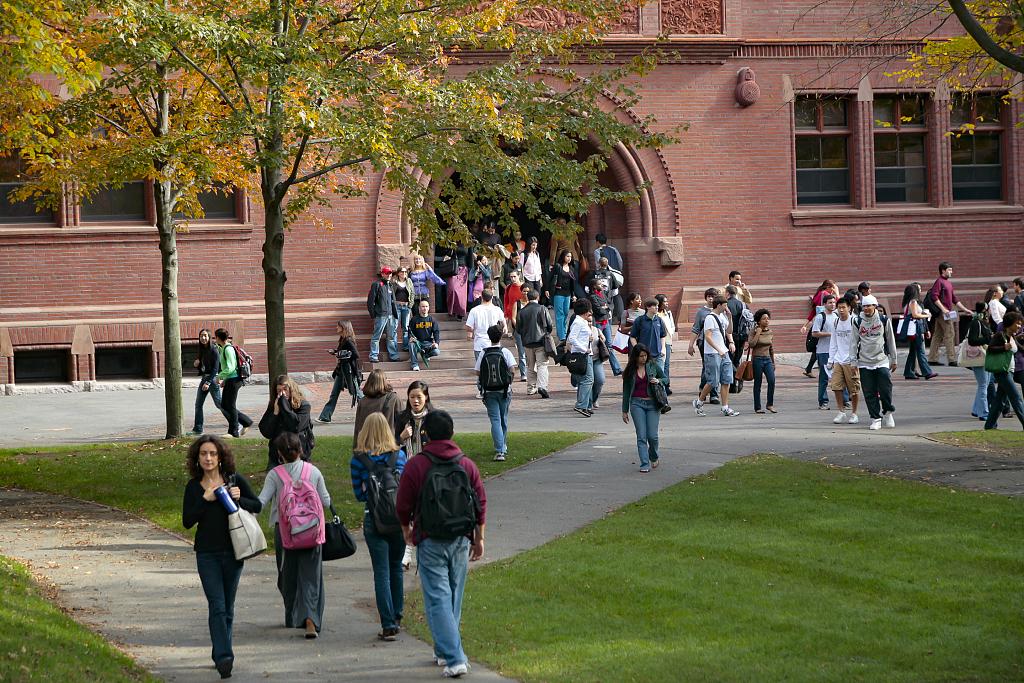US student debt forgiveness plan won't solve the problem
- By Mitchell Blatt
 0 Comment(s)
0 Comment(s) Print
Print E-mail China.org.cn, July 24, 2023
E-mail China.org.cn, July 24, 2023

Students walk to and from classes on the Harvard University campus on June 29, 2023. [Photo/VCG]
U.S. President Joe Biden announced his third attempt to cancel student debt on July 15, following his previous failed attempt to convince Congress to pass a bill eliminating student debt. Then when that didn't work, he used executive actions to eliminate student debt for many.
Now the Supreme Court has ruled that Biden's debt-eliminating executive actions were unconstitutional, so Biden is trying a different avenue. He is relying on a 1965 law governing higher education to write off up to $20,000 of debt per student.
Student debt is bad in the United States. Over 45 million Americans – close to 14% of the population – have college debt, and the average debt load is $30,000 (215,400 yuan). The value of all outstanding student loans in the country has skyrocketed from $500 billion in 2006 to well over $1,750 billion in 2021. It has grown so rapidly that student loan debt has eclipsed auto loans and credit cards as the second-largest source of borrowers' debt in the United States, behind only mortgage debt.
Debt is crippling students' economic futures, according to Biden's argument. It is preventing them from buying homes, saving for retirement, and starting businesses. According to the Council on Foreign Relations and the American Council on Education, it is also disproportionately impacting different racial groups: 86% of Black students borrowed to attend college compared with 70% of white students. However, the percentage of Hispanic and Asian students who borrowed to attend college is actually lower than the percentage of white students who did so.
But Biden's plan only addresses the symptoms, not the underlying problem: Students have to borrow so much money to pay for college because college is so expensive.
The average four-year cost of a public university increased from $8,000 in 1980 to $24,000 in 2019. At the same time, many universities and schools have cut funding for students in need. Pell Grants, a federal program to subsidize tuition for the neediest of students, are capped at $6,000 a year, the same amount they were at in 1980.
Biden's White House wrote in a statement: "Pell Grants once covered nearly 80% of the cost of a four-year public college degree for students from working families, but now only cover a third."
So why doesn't Biden increase the cap on Pell Grant funding? Why doesn't he do something to limit the cost of college tuition in the first place?
In 2003, tuition for students attending state colleges in their home states cost $4,202 a year. By 2023, it cost $11,541 a year. Of course, it's worse for students attending universities in a different state, and it's much worse for private schools. The cost of private university education rose from $19,009 to $44,433 over that same time frame.
Tuition costs are so high that some students have to refrain from attending university or attend a less prestigious university than they would have preferred in order to avoid taking on debt.
Conservatives call it unfair; they say Biden's plan only rewards people who took on debt and doesn't help financially responsible taxpaying citizens. Even if their gripe rings true to some, it is also hypocritical of them to advocate for cutting funding to students at the state and federal levels. Their complaining won't help those deprived students afford college either.
Republican attorney generals and activist groups may also file lawsuits against the new debt cancellation plan, and it will be back in court. Biden won't be president forever, and he can't justify temporary programs indefinitely and continue to fight lawsuits.
If President Biden cuts the debt of those recently-graduated students who still haven't repaid their debt, it will help some, but it won't solve the problem. An estimated 15 to 20 million more Americans will enroll in college next year, and they will still need to pay these sky-high tuition.
Mitchell Blatt is a columnist with China.org.cn. For more information please visit:
http://www.ccgp-fushun.com/opinion/MitchellBlatt.htm
Opinion articles reflect the views of their authors, not necessarily those of China.org.cn.





